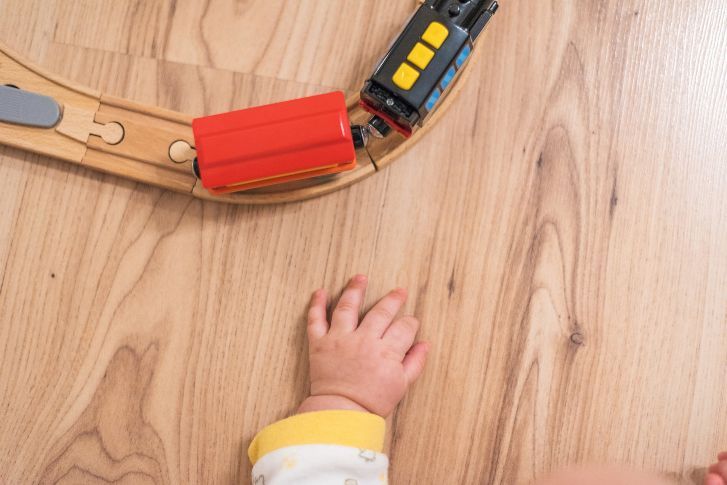Buyers Guide To Engineered Wood Flooring

Engineered wood flooring has all the aesthetic and tactile beauty of natural wood flooring with the added benefit of being tougher and more suited to the rigours of everyday home and family life. Another reason so many people choose engineered wooden flooring is that it is so straightforward and simple to lay.
What is Engineered Wood Flooring?
With a central core of plywood and a hardwood veneer engineered wood flooring has all the beauty and feel of hardwood flooring with the added benefits of extra durability, resistance to humidity and changes in temperature, and ease of installation.
Benefits of Choosing an Engineered Wood Floor
Engineered wood floors can cope with changes in temperature and humidity far better than solid wood floors. The manufacturing process of engineered wood means it is far less prone to the movements, swelling, and shrinking that hardwood flooring is susceptible to, especially in high humidity areas of the home such as kitchens and bathrooms.
The hardwearing nature of an engineered wood floor also means it is an excellent option for high traffic areas of your home and for busy family homes where floors need to be robust enough to cope with the messes, spills and the rough and tumble of children and pets.
As well as durability, engineered wood flooring has another huge advantage over solid wood flooring. That is the ease of installation.
Tips When Choosing Engineered Wood Flooring
When choosing your engineered wooden floor it is a good idea to consider the following:
- Core Quality. The quality of the undercore plywood affects both the price and the life of your floor. Multi-laminate hardwood ply is strong, durable, and least affected by temperature and humidity changes. Blockboard ply is a much cheaper option but will not have the stability of a multilaminate ply. It is especially not recommended for use over underfloor heating where it will be exposed to higher levels of heat stress.
- Thickness of the veneer. The hardwood veneer comes in a range of thicknesses and this will affect the durability and life of your floor. A 2mm thick veneer will simply not last as long as a 6mm veneer, which can even withstand sanding down to increase its life. Generally speaking the thicker the veneer the more expensive your floor will be.
- Wood Type. There is a variety of tree species that are used in the veneers of engineered flooring. The type of tree does not only affect the colour of the flooring but different woods have different qualities as well. For example, woods that have additional durability in high heat environments such as underfloor heating are oak or walnut. For high humidity areas such as bathrooms, teak is world-renowned for withstanding high levels of humidity.
- Dimensions. You should not only consider the dimensions of the room/s that your flooring will be laid but the length and width of the planks. Shorter, thinner planking may be cheaper, but will also take longer to lay. Visually as well you may find that smaller boards cut off much of the grain patterns of the wood, somewhat eradicating the real wood effect that this type of flooring provides. It is of course a matter of personal taste. Wider and longer planking means that you will see more of the grain patterns in the hardwood veneer and, although more expensive means that you will save time (and money if you are hiring a contractor) during the installation of your floor.
- Finish. Choosing whether to purchase ready-finished or pre-treated flooring or untreated flooring that you will apply your own choice of oils or lacquer to once it’s laid can be tough. Bearing the following in mind can help you choose. It is undoubtedly easier to buy engineered flooring that is pre-treated. Once laid that’s the job done. However, the quality of oils, lacquers, and other treatments that can be applied by hand after the floor has been laid is usually superior and allows for more freedom of choice of finish and colour.
Best Applications of Engineered Wood Flooring
Engineered wood flooring is suited to a variety of applications for your business and home. The extra stability and durable nature of engineered wood means that it can be used even in areas where natural solid wood flooring would not be recommended such as bathrooms, kitchens, conservatories, basements/cellars, summerhouses, or outdoor offices. Engineered wooden flooring is also suitable for use in conjunction with underfloor heating.
How Much Does Engineered Wooden Flooring Cost?
There is a wide variation in the cost of engineered wooden flooring dependent on a number of factors.
In short, it is likely to cost you from £30 per square metre to upwards of £100 per square metre. The variance in price is down to the quality of both core and veneer, the type of wood the veneer is made of, the dimensions and finish just to name a few factors.
However, it is worth budgeting as much as possible for your flooring you get what you pay for. A bigger spend initially will not only add value to your home but will last longer, require less maintenance, and look fantastic for many years to come.
How to Lay Engineered Wooden Flooring
How to lay your engineered wooden floor will depend on whether you have purchased tongue and groove or the click-together type of planking.
The following tips serve as a guide only, always follow the manufacturers instructions and if you are in doubt hire a qualified, experienced fitter.
- Check your site requirements. This will involve several tests such as moisture, humidity and whether the subfloor is level.
- Check the flooring unpack all of it and examine it carefully to ensure your order is correct and that you are happy with it. Repack for acclimatisation.
- Acclimatise your flooring by placing the packs of flooring in the room they will be used in. Spread them as much as possible to allow for as much air circulation as the space allows. Acclimatisation time should be at least 3 days but longer is better. 7 days is preferable.
- Ensure all of the existing floor covering is completely removed.
- When placing flooring allow an expansion gap.
- Do not glue or nail down flooring if you are using an underlay.
- Joins look better randomised and allow for a more natural effect.
- Open up several boxes and use them at once. This will help ensure that the natural changes in wood colouring and grain are spread throughout rather than having patches.
To find out about which types of engineered wooden flooring would work best for you, or to pick our brains about any of our other beautiful flooring solutions get in touch with us at Wooden Floors UK.


